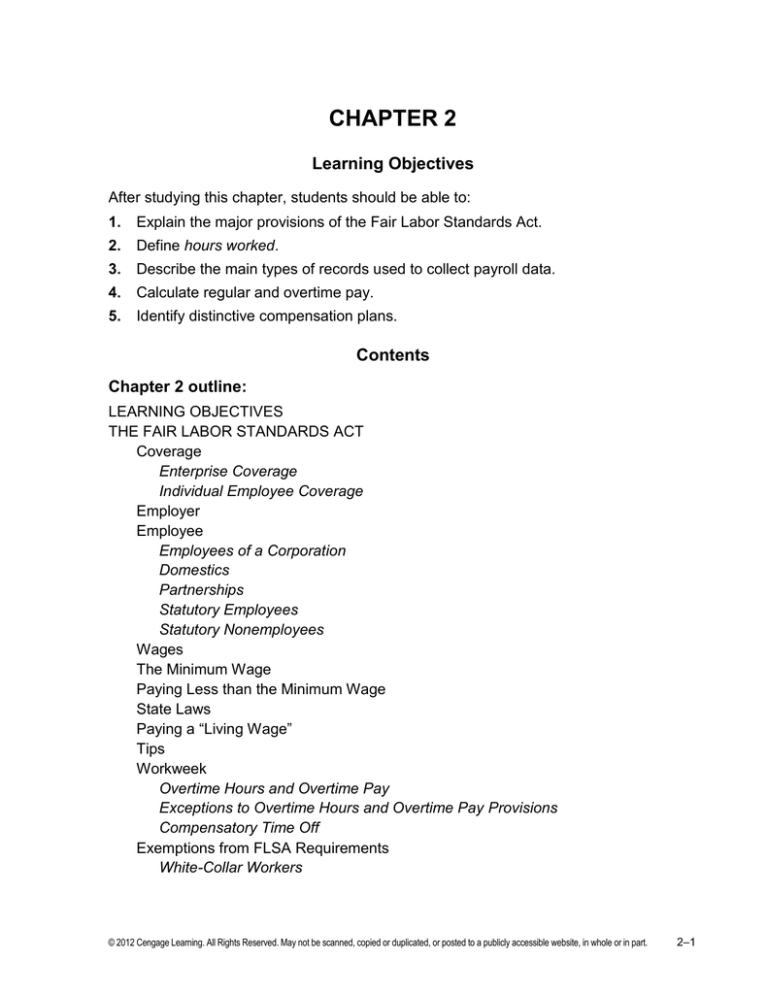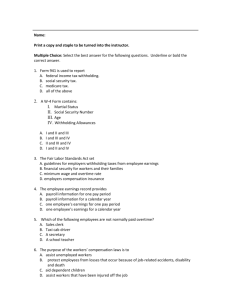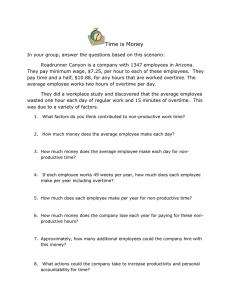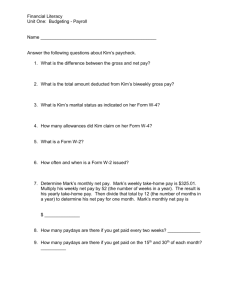
CHAPTER 2
Learning Objectives
After studying this chapter, students should be able to:
1.
Explain the major provisions of the Fair Labor Standards Act.
2.
Define hours worked.
3.
Describe the main types of records used to collect payroll data.
4.
Calculate regular and overtime pay.
5.
Identify distinctive compensation plans.
Contents
Chapter 2 outline:
LEARNING OBJECTIVES
THE FAIR LABOR STANDARDS ACT
Coverage
Enterprise Coverage
Individual Employee Coverage
Employer
Employee
Employees of a Corporation
Domestics
Partnerships
Statutory Employees
Statutory Nonemployees
Wages
The Minimum Wage
Paying Less than the Minimum Wage
State Laws
Paying a “Living Wage”
Tips
Workweek
Overtime Hours and Overtime Pay
Exceptions to Overtime Hours and Overtime Pay Provisions
Compensatory Time Off
Exemptions from FLSA Requirements
White-Collar Workers
© 2012 Cengage Learning. All Rights Reserved. May not be scanned, copied or duplicated, or posted to a publicly accessible website, in whole or in part.
2–1
2–2
Payroll Accounting
Test of Exemption
Salary Basis
Blue-Collar Workers
Equal Pay Act
Child-Labor Restrictions
Nonfarm Occupations
Agricultural Occupations
Certificate of Age
Penalties
Areas Not Covered by the FLSA
DETERMINING EMPLOYEE’S WORK TIME
Principal Activities
Clothes-Changing Time and Wash-Up
Travel Time
Idle Time
Waiting Time
Rest Periods and Coffee Breaks
Meal Periods
Taking Work Home
Sleep Time
Training Sessions
Doctor’s Appointments
Preliminary and Postliminary Activities
Fractional Parts of an Hour
Absences
Tardiness
RECORDS USED FOR TIMEKEEPING
Time Sheets
Time Cards
Computerized Time and Attendance Recording Systems
Next Generation
Touch-Screen Technology
Internet
Biometrics
IVR
METHODS OF COMPUTING WAGES AND SALARIES
Time Rate
Calculating Overtime Pay
Converting Weekly Wage Rates to Hourly Rates
Converting Biweekly Wage Rates to Hourly Rates
© 2012 Cengage Learning. All Rights Reserved. May not be scanned, copied or duplicated, or posted to a publicly accessible website, in whole or in part.
Chapter 2
2–3
Converting Monthly Salary Rates to Hourly Rates
Converting Semimonthly Salary Rates to Hourly Rates
Salaried Nonexempt Employees
Salaried with Fluctuating Workweek
BELO Plan
Piece Rate
Overtime Earnings for Pieceworkers—Method A
Overtime Earnings for Pieceworkers—Method B
Special Incentive Plans
Commissions
Nondiscretionary Bonuses
Profit-Sharing Plans
KEY TERMS
CHAPTER SUMMARY
Matching Quiz (p. 2–29)
1.
2.
3.
4.
5.
D
G
F
E
H
6.
7.
8.
9.
10.
C
J
B
I
A
Questions for Review (p. 2–30)
1.
The two bases of coverage provided by the FLSA are enterprise coverage and
individual employee coverage. Under enterprise coverage, all the employees of
an enterprise are covered if the enterprise has at least two employees who engage in interstate commerce or produce goods for interstate commerce and if the
enterprise has annual gross sales of at least $500,000.
Under individual employee coverage, the FLSA covers a worker if the employee
either engages in interstate commerce or produces goods for such commerce.
Employment in a fringe occupation closely related and directly essential to the
production of goods for interstate commerce constitutes engagement in the production of goods for interstate commerce.
2.
The IRS groups the items of evidence into behavioral control, financial control,
and the relationship of the parties.
3.
Retail or service establishments, farms, and institutions of higher education may
employ full-time students at 85 percent of the minimum wage.
4.
The living wage in Miami is $10.16 per hour (if the employer provides health insurance) or $11.41 per hour without insurance.
© 2012 Cengage Learning. All Rights Reserved. May not be scanned, copied or duplicated, or posted to a publicly accessible website, in whole or in part.
2–4
Payroll Accounting
5.
A tipped employee engages in an occupation in which tips of more than $30 a
month are customarily and regularly received. An employer can credit up to
$5.12 of a tipped employee’s minimum wage as coming from tips actually received.
6.
State employees working in the area of public safety may accumulate compensatory time off up to 480 hours. (The 480-hour limit represents 320 hours of overtime actually worked at the one and one-half overtime rate.) The employees may
“bank” their hours and use them later as time off at time and one-half during the
course of their employment.
7.
An employee would be paid for compensatory time off in the following two cases:
(1) At termination of employment.
(2) Upon reaching the “bank” maximum of 480 or 240 hours.
8.
The following employees are exempt from some of the requirements of the
FLSA:
a.
Amusement park employees are exempt from the minimum wage, equal
pay, and overtime provisions.
b. Taxicab drivers are exempt from only the overtime provision.
c. Casual baby sitters are exempt from the minimum wage, equal pay, and
overtime provisions.
d. Elementary school teachers are exempt from the minimum wage and overtime provisions.
e. Outside salespersons are exempt from the minimum wage and overtime
provisions.
9.
10.
The types of exempt white-collar employees are executives, administrators, professionals, highly compensated employees, computer professionals, creative
professionals, and outside salespersons.
To be classified as a highly compensated employee, he or she must:
(1) Earn $100,000 or more.
(2) Perform nonmanual work.
(3) Regularly perform one of the exempt duties of an executive, administrator, or
professional employee.
11.
The following conditions must be met:
(1) All work must be performed outside school hours.
(2) There is a maximum 3-hour day and 18-hour week when school is in session
(8 and 40, respectively, when not in session).
(3) Work must be performed between 7 A.M. and 7 P.M. (9 P.M. in summer).
12.
The principal activities of employees are those they must perform and include
any work of consequence performed for the employer. Principal activities include
those that are indispensable to the performance of productive work and those
that are an integral part of a principal activity.
© 2012 Cengage Learning. All Rights Reserved. May not be scanned, copied or duplicated, or posted to a publicly accessible website, in whole or in part.
Chapter 2
2–5
13.
The time spent by employees in traveling to and from work counts as time
worked only if contract, custom, or practice so requires. In some instances, however, travel time between home and work counts as time worked. For example,
when an employee receives an emergency call outside the regular working hours
and must travel a substantial distance to perform a job away from the usual work
site for one of the employer’s customers, the travel time counts as time worked.
14.
“Engaged to wait” is considered working time. An example would be workers
required to be at a car wash at a scheduled time waiting for car wash service
volume. “Waiting to be engaged” is not working time. This involves waiting for the
start of the working hours.
15.
Nonexempt employees must be paid for all hours worked, even those outside the
regular workplace. This also applies when employees take work home on their
own.
16.
The time spent by employees in attending lectures or training sessions does not
count as working time when all of the following conditions are met:
a. Attendance by the employee is voluntary.
b. The employee does not produce any goods or perform any other productive
work during the meeting or lecture.
c. The meeting or lecture takes place outside regular working hours.
d. The meeting or lecture is not directly related to the employee’s work.
17.
Preliminary and postliminary activities would be counted as time worked if required by custom or contract. In addition, if these activities are integral or indispensable to the employee’s main activities, compensation is required for this
time.
18.
A biometric time clock identifies an employee’s unique fingerprint, handprint,
voice, iris, or whole face.
19.
The Wage and Hour Division allows employers to round off employees’ worktime
to the nearest five, six, or fifteen minutes. This process must be applied consistently to all employees.
20.
The overtime premium pay is calculated by multiplying the overtime hours by an
overtime premium rate of one-half the regular hourly rate.
21.
To calculate the overtime hourly rate for employees who are paid biweekly, divide by 2 to arrive at the weekly salary. Divide the weekly salary by the regular
number of hours worked to obtain the hourly rate. Multiply this rate by one and
one-half to obtain the overtime rate.
22.
The regular rate of pay for a salaried nonexempt employee is found by dividing
the number of hours expected to be worked each week into the weekly salary.
23.
In the case of a salaried employee with fluctuating workweeks, overtime pay is
found by dividing the normal salary by the total hours worked, and then dividing
in half to get the extra half-rate which is paid for all the overtime hours.
© 2012 Cengage Learning. All Rights Reserved. May not be scanned, copied or duplicated, or posted to a publicly accessible website, in whole or in part.
2–6
Payroll Accounting
An alternative method would be to divide the fixed salary by 40 hours to determine a fixed hourly rate of pay, and then divide this in half to get the fixed extra
half-rate.
24.
Commissions are considered to be payments for hours worked and must be included in determining the regular hourly rate.
25.
Bonuses that are known in advance or that are set up as inducement to achieve
goals are nondiscretionary bonuses. This type of bonus is part of the employees’
wage rates.
Questions for Discussion (p. 2–30)
1.
The FLSA requires overtime pay for hours physically worked over 40 in a workweek. Hours that are paid for, but not actually worked, do not count toward the
40 hours. In addition, the hourly rate of pay is determined by dividing the total
regular pay actually earned by the total number of hours actually worked.
2.
No. Sanchez Printers, like other employers, may be inadvertently violating the
FLSA by giving employees a four-day Thanksgiving weekend and then expecting
them to make up the lost time later. Although there is no problem when an employer grants Thanksgiving Day and the following Friday as holidays, either with
or without pay, a violation arises if the employees are asked to work extra hours
without proper compensation in some other workweek to make up for the time
lost. Such an arrangement could violate payment of time and one-half for hours
over 40 in any workweek.
3.
Under the Fair Labor Standards Act, if the correct amount of overtime compensation cannot be determined until after the regular pay period, the company may
make the overtime payment as soon as is practicable but no later than the next
payday.
4.
In a case similar to the one described (69 LA 573), it was noted that the employer was more diligent in trying to correct paycheck errors that involved more than
$30. It was decided that there is no sufficient business reason why an error in a
small amount cannot be corrected as promptly as an error in a large amount. It
was ruled that the employer should look into the matter and inspect its records at
the earliest practicable moment. Further, it was concluded that errors should be
attended to as soon as feasible, irrespective of the amount due.
5.
First of all, the company pays Banta at two different wage rates based on the
hours worked at each separate job. As far as the overtime pay, there are three
options: (1) pay him one and one-half the higher rate for the overtime hours, (2)
calculate an average overtime rate based on the total time worked, or (3) if
agreed in advance, base the overtime rate on the job actually worked during the
overtime hours.
© 2012 Cengage Learning. All Rights Reserved. May not be scanned, copied or duplicated, or posted to a publicly accessible website, in whole or in part.
Chapter 2
2–7
Practical Problems (p. 2–31)
The principles and practices of payroll accounting discussed in Chapter 2 are applied
in the Practical Problems as shown below.
Principle or Practice
1.
Practical Problem No. (A and B)
Paying less than the minimum wage
(exception to the FLSA)
2–1
2.
Computing the tip credit
2–2, 2–5
3.
Computing gross earnings
2–3
4.
Computing regular earnings, overtime
earnings, and total gross earnings
2–4 through 2–21
5.
Computing salary—exempt employee
2–6
6.
Reading time cards to determine hours worked
2–9, 2–10
2–11 (continental
system)
7.
4/40 workweek
2–11
8.
Converting monthly and annual salary
rates to hourly rates
2–14, 2–15
Using the decimal system for “docking”
2–10
10.
Piece-rate systems
2–18, 2–19
11.
Commissions
2–20, 2–21
9.
Solutions—Series A Problems
2–1A.
(a)
37 hours × $4.20 = $155.40
(b)
Yes. Beck, a full-time student in a university, may be employed by a
retail establishment for at least 85% of the minimum wage, or $6.17
(85% × $7.25 = $6.1625, which the government rounds to $6.17).
Since Beck is being paid a rate less than $6.17, the wage rate violates the FLSA.
(c)
37 hours × $6.17 = $228.29
© 2012 Cengage Learning. All Rights Reserved. May not be scanned, copied or duplicated, or posted to a publicly accessible website, in whole or in part.
2–8
2–2A.
Payroll Accounting
(a)
$2.13 × 40 = $85.20* minimum weekly wages.
(b)
$ 85.20
– 80.00
$ 5.20
minimum weekly wages
weekly wage regularly paid
additional weekly wage due
*In order to be able to pay just the minimum ($85.20) for a 40-hour
week, the employee must receive at least $204.80 in tips ($290.00
$85.20).
2–3A.
(a)
Employee
Gross Earnings
Darley, R. ...............................................................................
Waxman, B. ...........................................................................
Isaac, J. .................................................................................
Bruner, H. ..............................................................................
Kellogg, P. .............................................................................
(b) Total gross earnings ....................................................
2–4A.
(a)
Employee
Regular
Earnings
Overtime
Rate
Overtime Total Gross
Earnings
Earnings
Carman, T. ..................
$378.00
$14.18
$ 99.26
Galasso, A. .................
476.00
17.85
35.70
Jones, B. ....................
354.00
13.28
106.24
Rodna, G. ...................
330.00
12.38
49.52
Wilmon, W. .................
296.00
11.10
61.05
(b) Total gross earnings .......................................................
2–5A.
$ 368.60
334.00
333.00
310.00
273.00
$1,618.60
(a) 40-hour pay (40 hours × $2.13).................................
(b)
Overtime pay {2 hours × $5.76 [($7.25 × 1.5) – $5.12]}
$ 477.26
511.70
460.24
379.52
357.05
$2,185.77
$85.20
$11.52
2–6A.
$80,000 ÷ 52 weeks = $1,538.46 × 2/5 = $615.38
2–7A.
(a)
Overtime earnings:
$22.20 ($14.80 × 1.5) × 7 hours = $155.40
(b)
Total earnings:
$592.00 + $155.40 = $747.40
2–8A.
(a) Regular pay (46 × $12.96) ........................................
$596.16
(b)
Overtime premium pay (6 × $6.48)............................
38.88
(c)
Gross pay ..................................................................
$635.04
© 2012 Cengage Learning. All Rights Reserved. May not be scanned, copied or duplicated, or posted to a publicly accessible website, in whole or in part.
Chapter 2
2–9A.
2–9
(a)
Hours worked each day:
Monday......................................................
Tuesday.....................................................
Wednesday ...............................................
Thursday ...................................................
Friday ........................................................
Saturday ....................................................
Sunday ......................................................
2–10A.
8
hours
10
hours
8
hours
10 1/2 hours
9 1/2 hours
4
hours
4
hours
(b)
Total hours worked .........................................
(c)
Regular earnings = 40 hours × $13.50......................
(d)
Overtime earnings:
Overtime earnings for hours beyond 8 daily and
for Saturday:
10 hours × $20.25 ($13.50 × 1.5) .........
$202.50
Overtime earnings for Sunday:
4 hours × $27.00 ($13.50 × 2) ............
108.00
(e)
Total earnings .................................................
(a)
Hours worked each day:
Monday......................................................
Tuesday.....................................................
Wednesday ...............................................
Thursday ...................................................
Friday .......................................................
(b)
Total hours worked .........................................
(c)
Gross earnings for the week:
38 9/10 hours × $12.15 .............................
54
hours
$540.00
310.50
$850.50
8
7
7
7
7
9/10
6/10
6/10
8/10
hours
hours
hours
hours
hours
38 9/10 hours
$472.64
2–11A. (a) Daily total hours:
Tuesday.....................................................
Wednesday ..............................................
Thursday ...................................................
Friday ........................................................
Saturday ....................................................
10
hours
10
hours
9 3/4 hours
10
hours
4
hours
(b)
Total hours for the week ................................
43 3/4 hours
(c)
Regular weekly earnings = 40 hours × $8.45...................
$338.00
(d)
Overtime earnings = 3 3/4 hours × $12.675.....................
47.53
(e)
Total weekly earnings ......................................................
$385.53
© 2012 Cengage Learning. All Rights Reserved. May not be scanned, copied or duplicated, or posted to a publicly accessible website, in whole or in part.
2–10
Payroll Accounting
2–12A. (a) Earnings, Job I: 40 × $14.00
=
=
Earnings, Job II: 7 × $11.80
$ 560.00
82.60
One-half overtime rate:
($560.00 + $82.60) ÷ 47 hours × 1/2 = $6.84
Extra overtime pay: 7 × $6.84
=
Gross pay
(b)
47.88
$690.48
40 × $14.00
7 × ($11.80 × 1.5)
=
=
$560.00
123.90
Gross pay
=
$683.90
40 × $14.00
7 × $11.80
7 × $5.90
=
=
=
$560.00
82.60
41.30
Gross pay
=
$683.90
OR
2–13A. $695 ÷ 40 = $17.38 hourly rate
$17.38 × 1.5 = $26.07 overtime rate
(a)
Regular earnings .......................................................
$695.00
(b)
Overtime earnings (5 hours × $26.07).......................
130.35
(c)
Total earnings ...........................................................
$825.35
2–14A. Yearly earnings:
$2,875 × 12
= $34,500
Weekly earnings:
$34,500 ÷ 52 = $663.46
(a)
Hourly rate:
$663.46 ÷ 40 = $16.59
(b)
Overtime rate:
$16.59 × 1.5 = $24.89
2–15A. Yearly earnings:
$2,575 × 12
= $30,900
Weekly earnings:
$30,900 ÷ 52 = $594.23
Hourly rate:
$594.23 ÷ 35 = $16.98
Overtime rate:
$16.98 × 1.5 = $25.47
(a)
Regular semimonthly earnings .......................
(b)
Overtime earnings:
Up to 40 hrs. (8 × $16.98) .........................
Over 40 hrs. (2 × $25.47) ........................
(c)
Total earnings ................................................
$1,287.50
$135.84
50.94
186.78
$1,474.28
© 2012 Cengage Learning. All Rights Reserved. May not be scanned, copied or duplicated, or posted to a publicly accessible website, in whole or in part.
Chapter 2
2–11
2–16A. Gross pay = $675 + [2 hours × ($18.00* × 1.5)] = $729.00
*$675 ÷ 37 1/2 hours
2–17A. (a) Overtime earnings: $1,050 ÷ 48 = $21.88 ÷ 2 = $10.94 × 8 .
$87.52
(b)
Total earnings: $1,050.00 + $87.52 .....................................
(c)
BELO pay: [($22.00 × 53 hours) + (13 hours × $22.00 × 0.5)] $1,309.00
2–18A. (a) Piecework earnings = 1,275 units × $0.35 .......................
$1,137.52
$446.25
(b)
Regular hourly rate:
$446.25 ÷ 45.5 hours = $9.81
Overtime hourly rate:
1/2 of $9.81 = $4.91
(c)
Overtime earnings = 5.5 hours × $4.91................................
27.01
(d)
Total earnings ......................................................................
$473.26
2–19A. (a) Piecework earnings = 1,075 units × $0.35 ...........................
$376.25
(b)
Overtime earnings = 200 units × $0.53 ($0.35 × 1.5)...........
106.00
(c)
Total earnings ......................................................................
$482.25
2–20A. (a) Regular annual salary ..........................................................
$29,500
(b)
Commission:
Commission on sales of $50,000 in
excess of $150,000 ($50,000 @ 8.5%)
$4,250
Commission on sales in excess of
$200,000 ($95,000 @ 10%) .................
9,500
Commission ....................................................................
13,750
Total annual earnings ..........................................................
$43,250
2–21A. (a) Weekly base salary ..............................................................
$340.00
(c)
Weekly gross sales .........................................
Less customer returns ...............................
Weekly net sales.............................................
$2,215.00
187.00
$2,028.00
(b)
Commission: $2,028.00 × 2% ..............................................
Weekly gross sales of cashmere sweaters .....
$ 995.00
Less customer returns ...............................
75.00
Weekly net sales of cashmere sweaters .........
$ 920.00
40.56
(c)
PM: $920.00 × 2% ...............................................................
18.40
(d)
Total weekly earnings ..........................................................
$398.96
© 2012 Cengage Learning. All Rights Reserved. May not be scanned, copied or duplicated, or posted to a publicly accessible website, in whole or in part.
2–12
Payroll Accounting
Solutions—Series B Problems
2–1B.
2–2B.
(a)
33 1/4 hours × $5.25 = $174.56
(b)
Yes. Cross, a full-time student in a university, may be employed by a
retail establishment for at least 85% of the minimum wage, or $6.17
(85% × $7.25 = $6.1625, which the government rounds to $6.17).
Since Cross is being paid a rate less than $6.17, the wage rate
violates the FLSA.
(c)
33 1/4 hours × $6.17 = $205.15
(a)
$2.13 × 40 = $85.20* minimum weekly wages.
(b)
$ 85.20 minimum weekly wages
– 75.00 weekly wage regularly paid
$ 10.20 additional weekly wage due
*In order to be able to pay just the minimum ($85.20) for a 40-hour
week, the employee must receive at least $204.80 in tips ($290.00
$85.20).
2–3B.
(a)
Employee
Gross Earnings
Duffy, M. .................................................................................
Hazelton, G. ...........................................................................
Inman, T. ...............................................................................
Palmer, C. ..............................................................................
Diaz, O. .................................................................................
(b) Total gross earnings ....................................................
2–4B.
(a)
Employee
Regular
Earnings
Overtime
Rate
Overtime Total Gross
Earnings
Earnings
Wilson, H. ....................
$476.00
$17.85
$ 53.55
Aha, C. ........................
568.00
21.30
42.60
Shoup, K. ....................
396.00
14.85
103.95
Carlyn, D. ....................
428.00
16.05
24.08
McMurray, J. ...............
684.00
25.65
128.25
(b) Total gross earnings .......................................................
2–5B.
(a) 40-hour pay (40 hours × $2.13).................................
(b)
2–6B.
$ 416.50
396.20
430.55
401.80
399.90
$2,044.95
$ 529.55
610.60
499.95
452.08
812.25
$2,904.43
$85.20
Overtime pay {3 1/2 hours × $5.76 [($7.25 × 1.5) – $5.12]} $20.16
$77,000 ÷ 52 weeks = $1,480.77 × 2/5 = $592.31
© 2012 Cengage Learning. All Rights Reserved. May not be scanned, copied or duplicated, or posted to a publicly accessible website, in whole or in part.
Chapter 2
2–7B.
2–8B.
2–9B.
2–10B.
2–13
(a)
Overtime earnings:
$25.35 ($16.90 × 1.5) × 7 hours = $177.45
(b)
Total earnings:
$676.00 + $177.45 = $853.45
(a) Regular pay (44 × $13.76) ........................................
$605.44
(b)
Overtime premium pay (4 × $6.88) ...........................
27.52
(c)
Gross pay .................................................................
$632.96
(a)
Hours worked each day:
Monday......................................................
Tuesday.....................................................
Wednesday ...............................................
Thursday ...................................................
Friday ........................................................
Saturday ....................................................
Sunday ......................................................
8
hours
11
hours
7 3/4 hours
10
hours
10
hours
4
hours
4
hours
(b)
Total hours worked .........................................
54 3/4 hours
(c)
Regular earnings = 39.75 hours × $14.10.................
(d)
Overtime earnings:
Overtime earnings for hours beyond 8 daily and
for Saturday:
11 hours × $21.15 ($14.10 × 1.5) .........
$232.65
Overtime earnings for Sunday:
4 hours × $28.20 ($14.10 × 2) ............
112.80
(e)
Total earnings .................................................
(a)
Hours worked each day:
Monday......................................................
Tuesday.....................................................
Wednesday ...............................................
Thursday ...................................................
Friday .......................................................
(b)
Total hours worked .........................................
(c)
Gross earnings for the week:
38 8/10 hours × $12.95 .............................
$560.48
345.45
$905.93
7
7
7
7
7
6/10
9/10
7/10
9/10
7/10
hours
hours
hours
hours
hours
38 8/10 hours
$502.46
© 2012 Cengage Learning. All Rights Reserved. May not be scanned, copied or duplicated, or posted to a publicly accessible website, in whole or in part.
2–14
Payroll Accounting
2–11B. (a) Daily total hours:
Tuesday ....................................................
Wednesday ..............................................
Thursday ...................................................
Friday ........................................................
Saturday ...................................................
10
hours
10
hours
9 1/2 hours
10
hours
4
hours
(b)
Total hours for the week ................................
43 1/2 hours
(c)
Regular weekly earnings = 40 hours × $9.35 ...................
$374.00
(d)
Overtime earnings = 3 1/2 hours × $14.025 .....................
49.09
(e)
Total weekly earnings ......................................................
$423.09
2–12B. (a) Earnings, Job I: 40 × $15.00
=
$600.00
Earnings, Job II: 9 × $13.10
=
117.90
One-half overtime rate:
($600.00 + $117.90) ÷ 49 hours × 1/2 = $7.33
Extra overtime pay: 9 × $7.33
=
Gross pay
(b)
65.97
$783.87
40 × $15.00
9 × ($13.10 × 1.5)
=
=
$600.00
176.85
Gross pay
=
$776.85
40 × $15.00
9 × $13.10
9 × $6.55
=
=
=
$600.00
117.90
58.95
Gross pay
=
$776.85
OR
2–13B. $725 ÷ 40 = $18.13 hourly rate
$18.13 × 1.5 = $27.20 overtime rate
(a)
Regular earnings ..............................................................
$725.00
(b)
Overtime earnings (4 hours × $27.20)..............................
108.80
(c)
Total earnings ..................................................................
$833.80
© 2012 Cengage Learning. All Rights Reserved. May not be scanned, copied or duplicated, or posted to a publicly accessible website, in whole or in part.
Chapter 2
2–15
2–14B. Yearly earnings:
$3,875 × 12
= $46,500
Weekly earnings:
$46,500 ÷ 52 = $894.23
(a)
Hourly rate:
$894.23 ÷ 40 = $22.36
(b)
Overtime rate:
$22.36 × 1.5 = $33.54
2–15B. Yearly earnings:
$2,650 × 12
= $31,800
Weekly earnings:
$31,800 ÷ 52
= $611.54
Hourly rate:
$611.54 ÷ 37.5 = $16.31
Overtime rate:
$16.31 × 1.5
= $24.47
(a)
Regular semimonthly earnings .......................
(b)
Overtime earnings:
Up to 40 hrs. (4 × $16.31)..........................
Over 40 hrs. (2 × $24.47) ........................
(c)
$1,325.00
$65.24
48.94
Total earnings .................................................
114.18
$1,439.18
2–16B. Gross pay = $735 + [2 hours × ($21.00* × 1.5)] = $798.00
*$735 ÷ 35 hours
2–17B. (a) Overtime earnings: $920 ÷ 42 = $21.90 ÷ 2 = $10.95 × 2 ....
$21.90
(b)
Total earnings: $920.00 + $21.90 ........................................
$941.90
(c)
BELO pay: [($21.00 × 45 hours) + (5 hours × $21.00 × 0.5)]
$997.50
2–18B. (a) Piecework earnings = 1,450 units × $0.38 .......................
$551.00
(b)
Regular hourly rate:
$551.00 ÷ 46 hours = $11.98
Overtime hourly rate:
1/2 of $11.98 = $5.99
(c)
Overtime earnings = 6 hours × $5.99...................................
35.94
(d)
Total earnings ......................................................................
$586.94
2–19B. (a) Piecework earnings = 1,120 units × $0.38 ...........................
$425.60
(b)
Overtime earnings = 330 units × $0.57 ($0.38 × 1.5)...........
188.10
(c)
Total earnings ......................................................................
$613.70
© 2012 Cengage Learning. All Rights Reserved. May not be scanned, copied or duplicated, or posted to a publicly accessible website, in whole or in part.
2–16
Payroll Accounting
2–20B. (a) Regular annual salary ..........................................................
(b)
$34,500
Commission:
Commission on sales of $50,000 in
excess of $150,000 ($50,000 @ 9.5%)
$ 4,750
Commission on sales in excess of
$200,000 ($115,000 @ 12%) ..............
13,800
Commission ....................................................................
Total annual earnings ...........................................................
18,550
$53,050
2–21B. (a) Weekly base salary ..............................................................
$400.00
(c)
(b)
(c)
(d)
Weekly gross sales ........................................
$2,715.00
Less customer returns ..............................
217.00
Weekly net sales ............................................
$2,498.00
Commission: $2,498.00 × 1% ..............................................
Weekly gross sales of cashmere sweaters ....
$ 895.00
Less customer returns ..............................
75.00
Weekly net sales of cashmere sweaters ........
$ 820.00
PM: $820.00 × 3% ...............................................................
Total weekly earnings ..........................................................
24.98
24.60
$449.58
Continuing Payroll Problems (p. 2–43)
See the completed payroll registers on pages CPP–1 through CPP–6.
Case Problems (p. 2–45)
Case 2–1
Some potential solutions that Delgado should consider are:
1.
2.
3.
Limit vacation accruals to a maximum, such as two or three weeks. This move
would reduce the current cost of payouts for earlier vacations granted at lower
wage rates.
Combine sick leave and vacation leave into one category called “annual leave.”
This practice enables a worker to use the leave time for any purpose—sick
leave, vacation time, child care, parental care, etc.
Adopt flexible time scheduling to enable workers to handle personal business,
such as medical and dental appointments, while they are flexing during the
workday.
Case 2–2
John should be made aware of the fact that the FLSA requires overtime pay for hours
physically worked over 40 in a workweek. Time paid for but not worked because of
holidays, vacations, sickness, jury duty, etc., is not included in the employee’s regular
rate of pay and does not count toward 40 hours worked.
© 2012 Cengage Learning. All Rights Reserved. May not be scanned, copied or duplicated, or posted to a publicly accessible website, in whole or in part.






